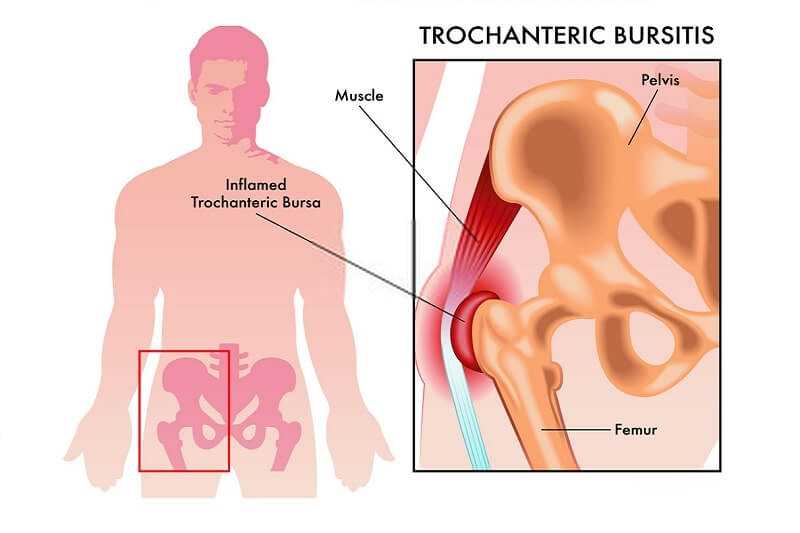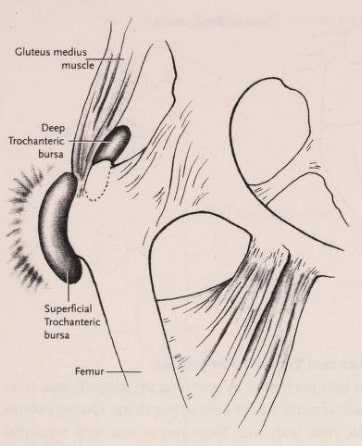About Trochanteric Bursitis

A bursa is a fluid-filled sac that acts as a cushion between tendons, bones, and skin. The trochanteric bursa is located on the upper, outer area of the thigh. There is a bump on the outer side of the upper part of the thigh bone (femur) called the greater trochanter, over which the trochanteric bursa is located. Trochanteric bursitis is an irritation or inflammation of the trochanteric bursa.

Causes
The trochanteric bursa may be inflamed by a group of muscles or tendons rubbing over the bursa and causing friction against the thigh bone (femur). This injury can occur with running, walking, or bicycling, especially when the bicycle seat is too high. It can also be brought about by repetitive activities and overtraining.
Symptoms
When suffering from trochanteric bursitis, you have pain on the upper outer area of your thigh or in your hip. The pain is worse when you walk, bicycle, go up or down stairs, or lie on that side. Generally, you have pain when you move your thigh bone and are tender in the area over the greater trochanter.

Diagnosis
Your doctor will ask about your symptoms and examine your hip, back, and thigh.
Treatments
Treatment may include rest or modification of activities or training; ice packs for twenty to thirty minutes every few hours for several days or until the pain goes away; anti-inflammatory medicine as prescribed by your physician; and/or a corticosteroid injection into the bursa to reduce pain and swelling.
While you are recovering from trochanteric bursitis, it is important to alter your routine to avoid exacerbating the injury. For example, you might try varying your exercise routine, perhaps by adding (or substituting) a low-impact activity like swimming.
The length of recovery depends on many factors, including your age, health, and history of previous injuries. Recovery time also depends on the severity of the injury; a bursa that is only mildly inflamed and has just started to hurt may improve within a few weeks, while a bursa that is very inflamed and extremely painful may take as long as a few months to heal. If you continue to perform activities that cause pain, your symptoms will return and you will take longer to recover.
General Tips for Prevention
Trochanteric bursitis is best prevented by warming up properly and conditioning the muscles on the outer side of your upper thigh. Do not overdo your exercise; if you do, your body may force you to rest with a painful injury.
Exercises for Prevention and Healing
These stretching and strengthening exercises of the outer hip area will help keep your trochanteric bursa from becoming irritated. The stretches should be done three times each; the strengthening exercises are designed to be performed in three to five sets of ten.
• Iliotibial band stretch (side-leaning): Stand sideways next to a wall, with your injured leg closest to the wall. Place the hand of your injured side on the wall for support, and cross your uninjured leg over the injured one, keeping the foot of the injured leg stable. Lean into the wall with your hip, hold the stretch for fifteen seconds, and release.
• Iliotibial band stretch (standing): While standing, cross your uninjured leg in front of your injured one and bend down and touch your toes. If you can do so without pain, move your hands across the floor toward the uninjured side to feel more of a stretch on the hurt side. Hold this position for fifteen to thirty seconds and release.
• Piriformis stretch: Lying on your back with both knees bent, rest the ankle of your injured leg over the knee of your uninjured one. Grab the thigh of your uninjured leg and pull that knee toward your chest; you will feel a stretch along the buttocks and possibly along the outside of your hip on the injured side. Hold this for fifteen to thirty seconds and release.
• Wall squat with A ball: Stand with your back, shoulders, and head against a wall and look straight ahead. Keep your shoulders relaxed and your feet shoulder-width apart, one foot away from the wall. Hold a rolled-up pillow or a soccer-sized ball between your thighs. Keeping your head against the wall, slowly squat while squeezing the pillow or ball. Squat down until you are almost in a sitting position (your thighs should not quite be parallel to the floor); hold this position for ten seconds and then slowly slide back up the wall. Make sure you keep squeezing the pillow or ball throughout this exercise.
• Straight leg raise: Lie on your back, with your legs straight. Tighten the top of your thigh muscle on the injured leg and lift it about eight inches off the floor, keeping the thigh muscle tight throughout. Slowly lower your leg to the floor and relax.
• Prone hip extension: Lie on your stomach with your legs straight. Tighten your buttocks and lift one leg off the floor about eight inches while keeping the knee straight. Hold for five seconds, then lower your leg to the floor and relax.





